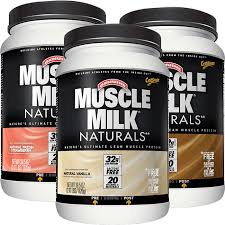Protein is vital to the health and development of humans, but its availability and expense can leave people lacking a proper diet. A quick, efficient solution to this problem is powdered protein that can be mixed into water or milk, or ready-to-go protein shakes. The soluble powder product allows for easy transportation and consumption of protein. This development has sparked a variety of companies and brands that have taken many different approaches to selling their protein powder or shakes. Many factors differentiate the products such as the amount of protein, flavor, solubility, texture, or additional nutritional benefits. The marketing campaign for most of these brands is focused on bodybuilding trends, workout fads, and athletic competitions. The campaigns advertise either bulking up, slimming down, or recovering from strenuous physical activity. One company that has become synonymous with protein shakes is Muscle Milk. Although their primary protein shakes boast many grams of protein and amino acid content per serving, they also produce a line of protein powder called Muscle Milk Naturals. Although the Naturals formula is intended to replicate natural human milk with minimal additional additives, the scientific remodeling that is done in order to reproduce the natural substance strays from the product’s advertised dogma.
The description of the product includes its benefits in the building and recovery of muscles, as well as not using artificial flavors, sweeteners, or colors. The description goes on to say that the product “features a custom protein, peptide, and amino acid matrix patterned after human mother’s milk”. This means that each compound that makes up this protein powder would have to mimic actual human milk. Surprisingly, the company’s claims were somewhat consistent with the scientific research performed by Pediatric Clinic of North America. The clinic determined that human milk during gestation periods is composed of whey and casein, which are commonly found in protein powder. The research also referred to peptide as a component of human milk. However, the amino acid matrix that the product description refers to appears to be jargon. The text on the components of human milk does not describe the amino acid makeup, therefore making it difficult to determine whether or not the product could mirror human milk’s amino acid matrix. The protein content in human milk is significantly less than that of Muscle Milk’s protein powder. Although the amount of protein in human milk is determined by the stages of the gestation period, it never approaches the 32 grams of protein in a serving of Muscle Milk Naturals. The typical percentage of protein content in human milk is 0.9%.
Since the US Food and Drug Association has not come up with a definition for the term “natural”, many companies have been given sufficient leeway. The ingredients for Muscle Milk Naturals sounds like a considerable amount of leeway: Protein Blend (Calcium Sodium Caseinate, Milk Protein Isolate, Whey Protein Isolate, Whey Protein Hydrolysate, Whey Protein Concentrate, Lactoferrin, L-Glutamine, Taurine), Cane Sugar, Natural Flavors, Sunflower Oil, Cocoa Powder, Maltodextrin, Canola Oil, Medium Chain Triglycerides, Crystalline Fructose, Less Than 1% Of: Potassium Chloride, Soluble Corn Fiber, Inulin, Dicalcium Phosphate, Magnesium Oxide, Potassium Bicarbonate, Stevia Extract, Soy Lecithin, Dl-Alpha Tocopheryl Acetate, Monk Fruit Extract, Ascorbic Acid, Ferrous Fumarate, Vitamin A Palmitate, Niacinamide, Zinc Oxide, Copper Gluconate, D-Calcium Pantothenate, L-Carnitine, Cholecalciferol, Pyridoxine Hydrochloride, Thiamin Mononitrate, Riboflavin, Chromium Chloride, Folic Acid, Biotin, Potassium Iodide, Cyanocobalamin. Human breast milk only has casein, riboflavin, and trace amounts of whey in common with the listed ingredients. However, “natural flavors” may be considered a component of breast milk.

The process for making the product is not clearly defined on the website, making it difficult to determine the strength of the term “naturals”. Since the formula is in a powdered form, it would not be reasonable to think that natural processes formed the substance. Even though Muscle Milk Naturals attempts to be unique from any product because it mimics human milk, the only difference from Organic Muscle Milk is that it isn’t ‘Certified Organic’. Therefore, it could be theorized that Organic Muscle Milk is actually more natural than Muscle Milk Naturals.
CytoSport boasting a potentially misleading label is not relatively new for the protein company. In 2009, Andrew Newman of the New York Times reported that Nestlé, the worldwide producers of many dairy based products and more, was suing Muscle Milk because the term ‘Milk’ was misleading. Nestlé argued that Muscle Milk’s use of the term led consumers to believe that they were drinking a dairy based product. The U.S Food and Drug association defines milk as the lacteal secretion, practically free from colostrum, obtained by the complete milking of one or more healthy cows.
However, according to Newman, the FDA is not overly strict when it comes to the enforcement of the definition. This is exemplified by the allowance of soy milk to be labeled as milk as well as other non-dairy milks.
In 2011, CytoSport had another legal battle over a misleading label. In 2011, a consumer sued Muscle Milk for having misleading information on their ready-to-go bottles such as “healthy” and “healthy, sustained energy”. According to the FDA, drinks that claim they are healthy and are low fat must have no more than 15% saturated fats composing the calories. Muscle Milk did not meet this requirement. The settlement resulted in CytoSport having to take the “healthy” off of the label and pay an impressive 5.3 million to settle the lawsuit.
The two lawsuits do not directly relate to the distinction on whether or not the Muscle Milk product should be labeled “natural”. However, it indicates that Muscle Milk is no stranger to stretching the truth on their labels. They use buzz words. The buzz word “healthy” lost them a considerable amount of money. Although the Muscle Milk Naturals doesn’t directly claim to be “Natural”, aside from the sweeteners and flavoring, using the buzzword at all to try and make a product more attractive has proven to be a dangerous marketing scheme.
Sources: (others linked in text)
https://www.ncbi.nlm.nih.gov/pmc/articles/PMC3586783/
https://www.accessdata.fda.gov/scripts/cdrh/cfdocs/cfcfr/CFRSearch.cfm?CFRPart=131
http://www.classaction.org/muscle-milk
http://www.fda.gov/AboutFDA/Transparency/Basics/ucm214868.htm









